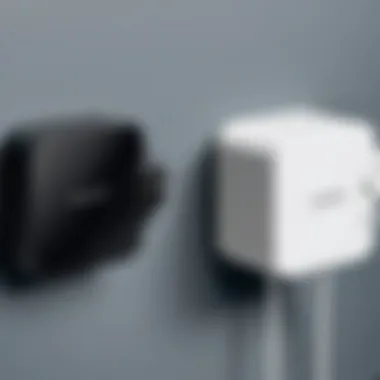Top Wall Chargers for Today's Tech Devices


Intro
In today's fast-paced world, the proliferation of electronic devices has transformed how we live, work, and connect. Chargers, which are often overlooked, play a crucial role in this modern ecosystem. Whether you’re a professional navigating complex IT landscapes or just someone who depends on devices for daily tasks, having the right wall charger is paramount.
The quest for a superior charging solution goes beyond simply plugging a device into the wall. Factors like speed, compatibility, and safety features can significantly impose on your user experience. With technology ever-evolving, so too should our choice of charging apparatus. Thus, delving into this arena of wall chargers is not only timely but essential.
By examining the latest innovations, standards, and recommendations, the aim is to arm readers with the knowledge they need to make informed decisions. Here’s an outline of what will be discussed:
- Introduction to various wall chargers and their key features.
- A comparative analysis of specifications and pricing.
- Performance reviews based on real-life usage.
- Insights into current trends shaping the charging landscape.
- Recommendations tailored to the needs of various users, particularly IT professionals.
As we embark on this exploration of the best wall chargers available in the market, keep in mind that quality and efficiency are not just luxuries; they are necessities for the modern technophile.
Understanding Charging Technologies
In today’s tech-centric world, understanding charging technologies is more than just a passing interest—it’s vital. With our ever-growing collection of gadgets, the demand for efficient and effective charging has never been higher. Comprehending these technologies isn't merely about knowing which charger pairs with which device; it’s the foundation upon which we optimize our charging solutions. This section explores various facets of charging technologies, illustrating how they impact our daily lives.
Overview of Charging Standards
Charging standards serve as the backbone for how devices communicate with power sources. These standards determine the efficiency, speed, and safety of charging. For instance, USB Type-C has become the go-to solution, due to its ability to deliver higher power and transfer data simultaneously. Additionally, many devices now support various protocols which ensures compatibility across diverse manufacturers. By grasping the intricacies of these standards, users can make informed choices, enhancing the longevity and performance of their devices.
The Evolution of Wall Chargers
Wall chargers have undergone substantial transformation over the years. Initially, devices charged slowly through bulky, singular plugs. Fast forward, and we now have compact chargers that can juice up multiple devices simultaneously. There’s been a drastic shift from analog to intelligent, adaptive chargers that recognize the power needs of the devices they connect to. The transition from mere convenience to enhanced functionality and accessibility has been major, impacting everything from mobile phones to laptops.
Current Technologies in Use
With the rapid advancements in technology, staying updated on current charging technologies is of utmost importance. Let’s break down three key players in this arena:
USB Power Delivery
USB Power Delivery (PD) is a game-changer in the charging landscape. It allows for power transfer up to 100 watts, making it suitable for a wide range of devices from smartphones to laptops. Its negotiation feature is noteworthy; devices and chargers communicate to deliver the optimal amount of power. This adaptability not only improves charging speed but also protects devices from damage caused by overvoltage.
Key Characteristic: The ability to deliver high power across multiple device types makes it popular.
Unique Feature: USB PD ensures safety and efficiency. However, it requires both the charger and device to support this standard, which might not always be the case.
Qualcomm Quick Charge
Qualcomm Quick Charge is designed to accelerate charging times significantly. Using its advanced technology, it allows compatible devices to charge up to 4 times faster than conventional methods. It achieves this by increasing the voltage supplied to the device.
Key Characteristic: Rapid charging time, which resonates with users in today’s fast-paced environment.
Unique Feature: While advantageous, it’s essential to note that not all devices can utilize this feature, potentially limiting its appeal among users with non-compatible devices.
Apple Fast Charge
Apple Fast Charge stands as a vital feature for Apple users, enhancing the charging capabilities of iPhones and iPads through higher wattage adapters. This technology allows devices to charge faster beyond regular rates—leading to significant battery replenishment in short periods.
Key Characteristic: Designed specifically for Apple products, ensuring optimal performance.
Unique Feature: Though it provides a speedy charging solution, users are required to purchase compatible chargers separately, which may not always be an ideal situation for everyone.
Understanding these various charging technologies equips tech enthusiasts and IT professionals alike with the knowledge to make smarter choices with their charging solutions. The advancements shape how our devices are powered, bringing efficiency and convenience to the forefront.
Key Features to Look For
When shopping for wall chargers, it's easy to get lost in the sea of options available today. However, understanding the vital features is what sets apart the good from the great. High-quality wall chargers ensure that your devices are charged quickly, safely, and efficiently. Let's delve into the critical elements you should pay attention to when selecting a charger for your devices.
Wattage and Charging Speed
First off, wattage plays a crucial role in determining how fast your devices will recharge. Different gadgets come with varying power requirements. For instance, while a smartphone might need around 10 to 20 watts, a tablet may require somewhere between 18 to 30 watts. Higher wattage typically translates to faster charging, but it’s pertinent to consider the specifications of your device. The catch is that a charger with too high a wattage can’t harm your device, as most modern electronics manage the power intake effectively. On the flip side, getting a charger with insufficient wattage means you’ll be waiting longer for that device to power up. So, knowing your device's needs can save you a heap of time in the long run.
Port Compatibility
Next on the list is port compatibility. With the shifting landscape in charging ports—USB-A, USB-C, and Lightning—having a charger that supports the connections of your devices is paramount. Many chargers now come equipped with multiple ports that support various charging standards, allowing users the flexibility of charging multiple devices simultaneously. Selecting a charger that has the right ports means convenience and efficiency, reducing the need for multiple chargers cluttering your workspace or travel bag.
Safety Features
Overcurrent Protection
Overcurrent protection is another significant feature. Think of it as a safety net that ensures the current flowing to your device doesn’t exceed its capacity. If there’s a power surge, the charger will automatically limit the current, preventing potential damage to your device. This feature has become a must-have for people concerned about the lifespan of their precious gadgets. It’s popular among tech enthusiasts who often use multiple devices simultaneously, as protecting against unexpected electrical issues is crucial for them.


Overvoltage Protection
Then there's overvoltage protection. This feature acts like a bouncer at a club—it limits the voltage supplied to your device to avoid overheating or damaging it. Most modern chargers include this function as part of their design, which is reassuring for users. The downside is that cheaper chargers may compromise on this safety feature to cut costs, so always check the specifications before buying.
Temperature Control
Lastly, temperature control is an essential aspect of safety features. If a charger gets too hot, it can become a fire hazard. A well-designed charger should have built-in mechanisms to regulate temperature, ensuring it doesn’t exceed safe levels during operation. This is particularly relevant in high-speed chargers where heat generation is often higher. The advantage of investing in chargers with this feature is unequivocal safety and reliability, especially important in homes with children or pets.
Design and Build Quality
To wrap up, the design and build quality of a charger can directly impact its performance and longevity. Opt for chargers made from durable materials that can withstand wear and tear. Lightweight designs often sacrifice sturdiness for portability, and while that can be useful for traveling, it's wise to find a balance that meets your lifestyle needs. Investing in well-designed, robust wall chargers not only enhances your device charging experience but also ensures you won’t be replacing chargers every few months.
Types of Wall Chargers
Understanding the various types of wall chargers is crucial in selecting what’s best tailored for one's needs. In today's gadget-centric world, the right charger can make all the difference in terms of efficiency and usability. There are distinct varieties of wall chargers, each catering to different charging demands and device compatibility. Let's dissect the primary types you might consider.
Single-Port Chargers
Single-port chargers are the simplest type available. They come with one output port, making them quite straightforward to use. These chargers are often compact, easy to carry, and perfect if you have a single device that needs a boost.
Benefits:
- Portability: Often lightweight and compact, these are convenient for travel.
- Simplicity: A no-fuss approach. If your device is the only one that requires charging, this type of charger fits the bill perfectly.
Using a single-port charger ensures that you can get the maximum charging speed designated for your specific device, as there's no sharing of power. However, if you often find yourself juggling multiple devices, this method might not suffice.
Multi-Port Chargers
Now, talking about multi-port chargers, these are the Swiss Army knives of wall charging solutions. With multiple ports, they let you charge several devices simultaneously—excellent for families or for those who frequently travel with multiple gadgets.
Considerations:
- Convenience: They keep your devices organized in one place.
- Speed: Depending on the charger, you might find quick charging capabilities across all ports.
Adding a multi-port charger to your arsenal not only declutters your charging station but can also be a time-saver. Just think: You can simultaneously power your smartphone, tablet, and watch without needing additional plugs around the house or office.
Smart Chargers
Smart chargers are the latest addition to the charger family. They come equipped with technology that recognizes the device connected to them and adjusts the power output accordingly. This means you get optimally tailored charging speeds without the guesswork.
Advantages:
- Efficiency: Charges your device more effectively without wasting energy.
- Intelligence: Many models come with safety features, protecting devices from overheating or overcharging.
Utilizing a smart charger can be a game-changer, especially in environments like offices where different team members might plug in various devices throughout the day. You can plug in a smartphone, and the charger communicates with it to provide the most efficient charging session.
In sum, choosing the right type of wall charger can greatly impact how effectively your devices are powered up, simplifying your daily routines and safeguarding your devices in the long run.
Comparative Analysis of Popular Brands
In an era where electronic devices dominate our daily lives, selecting the right wall charger can feel like finding a needle in a haystack. A comparative analysis of popular brands is not just a luxury; it’s a necessity. By examining the strengths and weaknesses of various manufacturers, consumers can make informed choices that align with their specific needs.
The benefits of assessing brands like Anker, Aukey, and RavPower go beyond mere specifications. It's about understanding how these companies address issues such as charging speed, safety, and user experience. Moreover, considering brand reputation can offer insights into long-term reliability and customer service, which are critical for IT professionals and tech enthusiasts alike.
When diving into this section, it’s important to take into account various elements:
- Charging Efficiency: How quickly and safely a charger can juice up a device.
- Design: Whether the build quality can withstand daily wear and tear.
- Compatibility: The range of devices that the charger can support.
- Price Point: Finding the balance between affordability and quality.
By studying these factors, you can better navigate the crowded charger market and pinpoint which brand will best serve your requirements.
Anker Wall Chargers
Anker has long been a titan in the charging industry. Known for its innovative design and reliable performance, Anker wall chargers are engineered for a wide array of modern devices. Their PowerIQ technology intelligently recognizes the device that is plugged in, adjusting charging speeds accordingly. This means you can charge your smartphone, tablet, or even some laptops with impressive efficiency.
- Key Features:
- Multi-Port Options: Anker offers chargers with multiple ports, making it easy to charge several devices at once.
- Durability: Built with high-quality materials, Anker chargers tend to have a longer lifespan than average products.
- Safety Protections: Numerous safeguards, including surge protection and temperature control, ensure peace of mind.
User testimonials frequently praise Anker for their customer service, which is an added benefit in today’s market.
Aukey Charging Solutions


Aukey stands out for its blend of affordability and efficiency. The company focuses on delivering value without sacrificing essential performance features. Their wall chargers often come equipped with advanced technologies such as Quick Charge, allowing for rapid device charging without overheating.
- Key Attributes:
- Compact Design: Many Aukey chargers are designed to be travel-friendly, making them ideal for on-the-go users.
- Multiple Charging Protocols: Compatibility with various fast-charging standards ensures wide applicability.
- Eco-Conscious: Aukey incorporates sustainable materials in many of its products, appealing to the environmentally aware consumer.
Aukey's reputation for dependability makes their products a worthwhile consideration.
RavPower Products
RavPower has carved out a niche by focusing on providing high-capacity options. Their products are particularly appealing to users who demand heavy-duty performance. With features like Power Delivery and rapid charging capability, RavPower strikes a balance between power and efficiency.
- Notable Features:
- High Wattage Options: Capable of charging laptops and other high-drain devices, RavPower meets the needs of professionals.
- User-Friendly Interface: Many RavPower chargers include LED indicators to show charging status.
- Versatile Port Selection: Including USB-C and USB-A ports, the diversity allows charging of multiple devices simultaneously.
In reviewing RavPower, one can gauge the brand's commitment to providing effective solutions for demanding users.
"When choosing a wall charger, evaluating a brand can significantly influence both performance and overall user experience."
Best Wall Chargers for Specific Needs
Choosing the right wall charger for modern devices is not a one-size-fits-all situation. The diverse range of gadgets we use demands careful consideration. Whether you’re racing against the clock to top up your phone before heading out or seeking a reliable setup for everyday home use, there’s a charger out there tailored just for your needs. This section delves into the specifics, illuminating the unique requirements for charging in different contexts—the spotlight being on fast charging, travel-friendly options, and home setups.
For Fast Charging
In today’s fast-paced world, time is often of the essence. Fast charging lets you power up your devices quickly, which is crucial for professionals constantly on the go. The importance lies not only in speed but also in convenience. Imagine running out the door to a meeting, only to realize your phone is barely holding a charge. With a suitable fast charger, you can give your device a notable boost in just about half an hour. Devices like the Anker PowerPort Atom PD 1 can deliver high wattage with compatible devices, making sure you aren't left scrambling for a power source.
Considerations include compatibility with charging standards such as USB Power Delivery or Qualcomm Quick Charge. These technologies provide not just speed but also versatility for a range of devices. Additionally, look for chargers with multiple fast charging ports; that way, multiple gadgets can benefit from the quick juice without hogging a single outlet.
For Travel
Traveling presents a unique set of challenges when it comes to charging devices. More often than not, the last thing you want is to lug around a bulky charger. Portability becomes paramount, making compact and lightweight chargers highly desirable. Wall chargers designed for travel, such as those from Aukey, often include features like foldable plugs and multi-port outputs, ensuring you can connect several devices without being weighed down.
A key factor to consider is voltage compatibility. Different countries use different voltage systems, and using the wrong one could lead to damage or inefficient charging. Many modern travel chargers come with automatic voltage adjustment capabilities, thus making your life easier while globetrotting. In fact, opting for a charger that supports a wide voltage range reduces stress during your travels, as you won’t have to constantly check your gadgets' compatibility with the local electric system.
"Buying a travel-friendly wall charger can save tons of frustration during your trips, letting you connect without worries."
For Home Use
Setting up a charging station at home requires a bit of foresight, as multiple devices may require simultaneous charging. A robust multi-port wall charger can cater to the needs of the entire household. These chargers often blend both functionality and efficiency, allowing all family members to connect their devices without delay.
When selecting chargers for home it’s crucial to consider the overall wattage. A RavPower 6-Port USB Charger, for example, enables users to charge several devices at once while protecting them from overcurrent and other issues thanks to built-in safety features. Beyond this, look for additional features like LED indicators for each port, which inform users whether their devices are receiving power, ensuring convenience and reassurance.
In summary, the right wall charger can make a world of difference in how efficiently and effectively we power our devices. By considering the unique requirements for fast charging, travel, and home use, you can select a wall charger that not only meets your needs but also enhances your device experience.
Installation and Usage Considerations
Understanding installation and usage considerations is paramount for anyone looking to enhance their charging experience. Wall chargers are more than just plugs; they are an integral part of ensuring your devices operate efficiently. When you get it right, you not only maximize charging speed but also promote safety and durability for both the charger and your devices.
Proper Installation Techniques
Installing a wall charger may seem straightforward, but there are several practices to ensure it’s done correctly. First off, make sure you are using an outlet that is suitable for the charger's prescribed voltage. This often means checking if the outlet is grounded and that you aren’t overloading it by plugging in multiple high-wattage devices.
- Check Compatibility: Different devices have varying power requirements. Always pair your charger with a compatible outlet.
- Avoid Overcrowding: It’s tempting to use power strips, but overcrowding can lead to overheating. Use one outlet per high-wattage charger.
- Secure Connection: Ensure the charger fits snugly in the outlet. A loose connection can cause arcing, which may lead to electrical fires.
By following these techniques, you lay down the groundwork for safe and efficient usage.
Optimal Usage Practices
Once installed properly, using your wall charger effectively takes center stage. Every device has a unique charging cycle, and understanding this can prolong battery lifespan. Here are some practical tips to consider:
- Avoid Extreme Temperatures: Keeping your charger in a place away from extreme heat or cold can prevent damage. Both charger and device should be room temperature for optimal operation.
- Unplug When Not in Use: Leaving chargers plugged in can generate a small amount of unused energy and may lead to unnecessary wear.
- Use Quality Cables: A charger is only as good as the cable it uses. Opt for high-quality cables to prevent slow charging and minimize risk of fraying.
- Regular Inspection: It's wise to periodically assess your charger for signs of wear or damage. A frayed wire or cracked casing can pose serious safety risks.
Adopting these practices fosters not just efficiency but also enhances device safety, ensuring that your technological investments work smoothly for years to come.
Troubleshooting Common Issues
In the fast-paced world of technology, issues with charging can be a real thorn in one's side. Understanding common problems and their solutions is essential for optimizing device performance. A proper grasp of troubleshooting methods not only enhances efficiency but also extends the lifespan of both the wall charger and the device it energizes. By addressing these challenges, users can ensure that their charging setup remains reliable and effective.
Charger Not Recognized


One of the more frustrating experiences users encounter is when their wall charger fails to be recognized by the device. There are several potential culprits for this conundrum. First, check the connection; a loose or obstructed port can easily create issues. If muck or debris accumulates in the charging port, it may prevent proper conductivity.
If the connection looks solid, consider the cable itself. Some cables have a shelf life and may start to fail over time, leading to the ‘charger not recognized’ message. It's also worth looking at the compatibility between the charger and the device. Not all chargers are created equal; verify that you’re using a charger that meets the specific requirements of your gadget. Lastly, sometimes a simple reboot of the device can resolve the recognition problem.
Slow Charging Speed
Experiencing a sluggish charging speed can feel akin to watching paint dry, especially in a world that thrives on efficiency. If your device takes ages to charge, a few things could be at play. Firstly, assess the wattage of your charger. If the specified wattage is low, it essentially works at a crawl compared to a higher-capacity charger.
Moreover, multiple devices plugged into a multi-port charger may share the total wattage, reducing charging speed for each device. Check also for any software updates that might be overdue; outdated software can hamper functionality. Lastly, consider whether the environment itself is a factor. Extreme heat or cold can affect charging performance; keeping devices in a temperate zone is key.
Overheating Problems
Overheating is another issue that can plague wall chargers and devices alike. When devices get too hot, it can damage internal components, leading to an early demise. Several factors contribute to this issue: poor ventilation, usage while charging, or even low-quality chargers.
Ensure that whatever space the charger occupies is well-ventilated. Allowing some air to circulate can do wonders for temperature management. If you find yourself frequently using your device while it charges, try to minimize this practice as it often leads to greater heat generation. Lastly, using chargers from reputable brands can provide peace of mind; cheap knock-offs often lack essential safety features that help avoid overheating incidents.
Maintaining the functionality of your wall charger and devices hinges on addressing these common issues promptly. Whether it’s recognizing your charger, fixing sluggish speeds, or managing overheating, staying informed can save you from future headaches.
Environmental Impact of Wall Chargers
As the world becomes increasingly dependent on electronic devices, the significance of assessing the environmental impact of wall chargers cannot be overstated. Every device, be it a smartphone, tablet, or laptop, requires a reliable power source, leading to a surge in charger production. These chargers, while seemingly innocuous, present several environmental challenges, from resource consumption during manufacturing to disposal issues that contribute to electronic waste. Understanding these facets is essential for IT professionals and tech enthusiasts looking to make informed decisions that align with sustainability goals.
The production of wall chargers often involves materials that are not environmentally friendly. For instance, the plastic used in charger bodies and the metals that compose the circuitry require extraction processes that can damage ecosystems. Moreover, non-renewable resources are commonly utilized, making the entire lifecycle of a charger a point of concern from an environmental sustainability perspective.
Thus, a closer look at sustainable practices and materials can help minimize this impact. Responsible consumption and accompanying actions can pave the way for more eco-friendly alternatives in the marketplace, which brings us to the core elements of sustainable materials in the next section.
Sustainable Materials and Practices
Emphasizing the usage of sustainable materials in the production of wall chargers can lead to significant environmental benefits. Chargers constructed from biodegradable plastics or recycled metals represent a step in the right direction. This shift ensures that fewer new resources need to be extracted, thereby conserving natural ecosystems.
Using sustainable materials not only reduces waste but can also enhance the ecological footprint of products.
Some manufacturers have begun to make strides towards sustainability by adopting responsible sourcing of materials. This means that sourcing is done with an eye towards accountability, ensuring that the components are not only functional but also ecologically sound. Additionally, robust designs that extend a charger's lifespan counterbalances the tendency for disposable culture. In other words, investing in a high-quality charger can mitigate the need for multiple replacements down the line.
Key Points on Sustainable Practices:
- Material Choices: Opt for brands that prioritize biodegradable and recycled materials.
- Durability: Select chargers that have longer life cycles to reduce waste.
- Energy Efficiency: Consider chargers designed to minimize energy loss during the charging process.
Recycling and Disposal Guidelines
When the time comes to dispose of old or non-functioning chargers, the approach can greatly affect the environment. E-waste is a growing concern globally, and improper disposal of chargers contributes to this issue. Many chargers consist of a mix of plastic and metal, which complicates the recycling process if not handled correctly.
It's essential to follow proper recycling and disposal guidelines to minimize environmental harm. Many communities have e-waste collection programs or designated drop-off locations for electronic devices where chargers are accepted. Participating in these programs not only ensures responsible disposal but also aids in recovering valuable materials that can be reused in new products.
To assist your transition into sustainable practices, here’s a list of disposal options:
- Manufacturer Take-Back Programs: Many tech companies offer recycling for old chargers when you purchase a new one.
- Local E-Waste Events: Keep an eye out for community events focused on recycling electronic waste.
- Repair or Refurbish: In some cases, chargers can be repaired, thus extending their usable life.
By understanding the broader implications of wall chargers, from their production to their disposal, tech enthusiasts can make choices that lessen their environmental footprint. Through these actions, it becomes possible to contribute to a more sustainable future in technology.
Future Trends in Charging Technology
The landscape of charging technology is evolving more rapidly than ever, an evolution driven by our insatiable demand for faster, more efficient, and innovative ways to keep our devices powered. As we delve into the future trends in charging technology, it highlights the relevance of understanding these shifts within the context of modern gadgets. With the increasing number of portable devices per consumer, it's imperative that IT professionals and tech enthusiasts grasp these changes to optimize their charging solutions. This section elucidates the key advancements and what they can offer to users, laying the groundwork for choosing the right charging solutions as technology progresses.
Wireless Charging Developments
Wireless charging has become the talk of the town in recent years, and for good reason. This technology liberates users from tangles of cords, presenting a practical and sleek solution. Let's break down how it's developing:
- Improved Efficiency: New standards like Qi and AirFuel are being refined, focusing on enhanced power transfer. These improvements reduce energy loss and contribute to quicker charging times, making it viable for everyday usage.
- Integration with Everyday Furniture: Imagine charging your device simply by placing it on a desk or nightstand. Companies are beginning to integrate charging pads into furniture designs, transforming them into power hubs that blend seamlessly into your environment.
- Increased Compatibility: The push towards universal wireless charging standards is gaining ground. This means you can expect one charger to possibly work across multiple devices, regardless of brand, in the future.
"Wireless charging is about convenience and the future seems to lean heavily towards making it accessible everywhere."
However, while it presents numerous advantages, some considerations should not be overlooked:
- Electromagnetic Interference: As with many new technologies, there's potential for interference, which can impact how devices interact during charging.
- Cost of Implementation: As businesses and consumers seek the adoption of this technology, upfront costs for both devices and furniture can be prohibitive.
Advancements in Fast Charging Technologies
Fast charging is another frontier leveraging its way into mainstream use. Technologies like USB Power Delivery and Qualcomm Quick Charge are reshaping our expectations. Here’s what’s cooking:
- Higher Wattage Capability: New standards are allowing for charging at much higher wattages. This means a phone can reach full charge as quickly as it takes to drink a cup of coffee!
- Smart Charging Algorithms: Devices are getting smarter. They can now negotiate the power they need based on their charge state, which not only speeds up charging but also protects battery health in the long run.
- Broadening Compatibility: Developments aim for fast charging features to be universally compatible across devices, minimizing the confusion and hassle of different cables and adapters.
The future of fast charging looks promising but requires a caveat:
- Heating Issues: High-speed charging traditionally generates more heat. With advancements, manufacturers are working tirelessly to mitigate overheating while maintaining efficiency.
- User Education: With new technologies emerging, user understanding of how to properly utilize these fast chargers will be paramount to ensure longevity and safety of their devices.
Keeping an eye on these trends not only aids in making informed purchase decisions but also ensures you're well-equipped for the charging needs of tomorrow.

